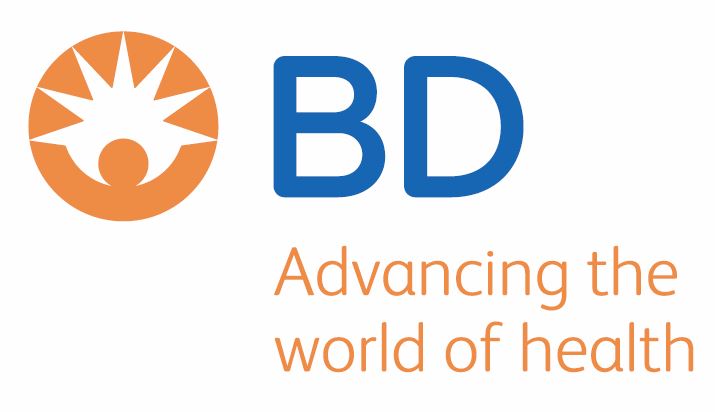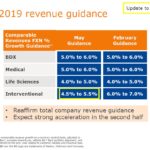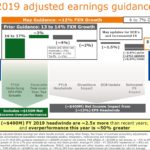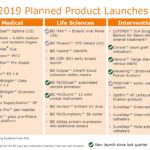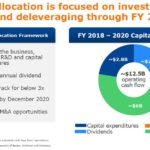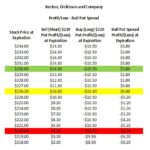Contents
Becton, Dickinson and Company (BDX) has just released Q2 results which includes lowered FY2019 earnings guidance.
Based on my analysis and long-term prognosis I view BDX as currently being undervalued.
Summary
- BDX recently released Q2 results and lowered FY2019 guidance resulting in a sudden drop in the share price.
- Management expects the second half of FY2019 to be superior to the first half and I view the share price pullback as a buying opportunity.
- Should you not be prepared to acquire BDX shares but are in agreement the share price has a very reasonable probability of rising before the second half of December you may wish to employ the option strategy presented.
Introduction
In early November I disclosed that I had exited a position in a company in which I had been a long time shareholder in favor of increasing my position in Becton, Dickinson and Company (BDX).
My subsequent BDX related articles can be found here, here, and here. In these articles I indicate I viewed BDX’s valuation as excessive and disclosed my out-of-the-money covered calls to generate additional income.
I presently have several covered call contracts with a $260 strike price which expire May 17th. With shares currently trading at $225.40 I fully anticipate these contracts will expire worthless. This essentially means I retain 100% of the option premium I collected at the time I executed the option trade AND I retain the underlying BDX shares.
Q2 2019 Results and 2019 Guidance
On May 9th, BDX released its Q2 2019 results in which FY2019 guidance was lowered.
This downward revision is partially attributed to a March 15th letter issued by the FDA to health care providers regarding paclitaxel-coated devices (drug-coated balloon (DCB)) used to treat peripheral arterial disease in the femoropopliteal artery. Based upon the FDA’s preliminary analysis of long-term follow-up data, there is a potentially concerning signal of increased long-term mortality regarding the paclitaxel-coated device use. BDX’s statement regarding the FDA’s concerns can be found here.
The FDA’s recent statement has resulted in a significant decline in the sale BDX’s DCB products. This has resulted in management lowering revenue guidance; a reduction in DCB sales of ~50% is expected over the remainder of the year. Total revenue growth guidance of 5% - 6%, however, is still expected.
In addition to the DCB issue, BDX has experienced a worse than previously guided currency environment. Based on current rates, BDX expects a ~200 bps currency headwind. This is driven by a broad strengthening of the USD against other currencies. Management’s current forecast reflects the euro to dollar exchange rate of $1.12 versus an original expectation of $1.16.
Adjustable EPS growth is now expected to be $11.65 - $11.75 versus previous guidance of $12.05 - $12.15.
On the May 9th Q2 earnings call, management indicated that the magnitude of the headwinds BDX faces is significantly greater than the headwinds encountered in recent years. The total headwinds amount to ~$0.4B. BDX has the ability to offset ~$0.15B in FY2019 which is 50% more than what has been offset in each of the past few years.
On the operating cash flow front, management anticipates ~$4.1B for FY2019 versus the previous ~$4.2B guidance.
Cost synergies from the C.R. Bard acquisition are expected to come in at ~$0.1B this current fiscal year and management is confident it will be able to realize ~$0.3B in annualized cost synergies over 2018 - 2020.
Several new product launches in each of BDX’s 3 segments are on tap for the remainder of FY2019.
Credit Ratings
While I recommend BDX as a long-term investment I wish for you to be fully cognizant that there is an elevated level of risk when investing in BDX. This is the result of the significant long-term debt BDX took on for the purposes of acquiring Carefusion and C.R. Bard.
BDX’s credit ratings (BBB (S&P) BBB-(Fitch) Ba1 (Moody’s)) place it in the top tier of the non-investment grade speculative category.
At the time of the C.R. Bard acquisition, BDX was well aware that the investment community viewed the degree of leverage to be somewhat elevated. It, therefore, committed to deleverage the Balance Sheet to below 3x within a 3 year timeframe.
On the Q4 and FY2018 November 6, 2018 earnings call management indicated ~$0.7B in debt had been repaid in Q4 and ~$1.2B had been repaid in FY2018; this was slightly ahead of initial expectations. Following this repayment, the gross leverage ratio had declined to 3.9 times as of September 30.
On the Q1 2019 February 5, 2019 earnings call management indicated that ~$0.4B of debt had been repaid resulting in the gross leverage ratio declining to 3.8x as of December 31, 2018.
On the Q2 2019 May 9, 2019 earnings call, management indicated a further $0.5B had been repaid on the company’s long-term debt.
On each and every quarterly conference call, management reiterates that BDX is on track to achieve the commitment to deleverage the Balance Sheet to below 3x within a 3 year timeframe.
Dividends and Dividend Yield
BDX’s dividend and stock split history can be found here. While BDX views maintaining its lengthy track record (47 years) of dividend increases as important, deleveraging the Balance Sheet is also a high priority. As a result, the degree to which BDX’s dividend has increased in the last couple of years is lower than in previous years. In my opinion, investors should temper their expectations when it comes to dividend growth until such time as management achieves its leverage target (see above).
Using the current $225.40 share price and the $0.77/quarter ($3.08/year) dividend we arrive at a ~1.4% dividend yield. Many investors will pass on investing in BDX because of this low dividend yield. As a long-term BDX investor, however, I prefer to see management give priority to the strengthening of the Balance Sheet versus dividend growth.
I draw to your attention the following capital allocation guidance management provides at the January 22, 2019 AGM. As you can see, debt repayment makes up the lion’s share of how capital is to be allocated.
Valuation
At the time of my January 10, 2018 article, a dozen analysts had projected FY2018 adjusted diluted EPS of $10.87. Based on the ~$223.7 closing stock price at the time, the forward adjusted diluted PE was ~20.6.
When I wrote my January 30, 2018 article, BDX was trading at $246.28. Using the unchanged projected FY2018 adjusted diluted EPS for FY2018 I arrived at a forward adjusted diluted PE of ~22.66.
In my November 6, 2018 article I noted that BDX was trading at $240.69 and that FY2019 adjusted diluted EPS guidance of $12.05 - $12.15 had just been released. Using the $12.10 mid-point I arrived at a forward adjusted diluted PE of ~19.9.
When I wrote my February 6, 2019 article, Q1 2019 adjusted diluted EPS guidance reflected no change from the November 6th guidance. Shares were trading at ~$242.50 giving us a forward adjusted diluted PE of ~20.04.
Q2 2019 results have now been released and FY2019 adjusted diluted EPS guidance has been lowered to $11.65 - $11.75 ($11.70 mid-point). With shares priced at $225.40 we get a forward adjusted diluted PE of ~19.26.
BDX’s shares are currently more attractively valued than at the time of my recent previous articles.
Option Strategy
I have previously written covered calls when I thought BDX was richly valued and expected the share price to remain below my strike price. This, however, is currently not the case so I will not be writing covered calls.
If you are in agreement BDX is attractively valued and do not wish to acquire shares, I present the following low risk bullish option strategy for your consideration.
Bull Put Spread
The use of a Bull Put Spread provides you with the opportunity to profit from neutral to bullish price action in the underlying stock. Profit is generated from either a rising stock price or from time erosion or from both.
This option strategy consists of one short put with a higher strike price and one long put with a lower strike price; both options have the same expiration date.
The reason I recommend this spread strategy versus a Bull Call Spread is because in the case of the Bull Put Spread you receive a net credit at the time you execute your trades. If you elect to use a Bull Call Spread you must lay out money at the time of your option trades.
Your potential profit is limited to the net premium received less commissions and your potential loss is limited if the stock price falls below the strike price of the long put.
I suggest the December 20, 2019 option expiry because BDX’s fiscal year end is September 30th and results are released within the first 10 days of November.
As I compose this article, however, I see the last $230 Put was traded May 7th which is before the release of BDX’s Q2 results on May 9th. The $220 Put was last traded May 9th after Q2 results were released. As a result, there is only a $0.95 spread between the $220 and $230 ‘last price’ which is not realistic given that there is a $10 difference between the 2 strike prices.
Since the current posted option prices do not reflect the ‘true’ value of both strike prices, I will use the option prices for the September 20th expiry; the options at both strike prices were traded following the release of Q2 results. Once there is activity for the December 20th expiry you can follow my example to calculate your breakeven, maximum loss, and maximum profit levels.
Sell September 20, 2019 $230 Put for $14.30/share or $1430/contract
Buy September 20, 2019 $220 Put for $10.50/share or $1050/contract
Net Funds received at time of trade $3.80/share or $380/contract (excludes commission)
NOTE: 1 option contract = 100 shares
Breakeven
The breakeven is calculated as the higher strike price minus the net premium received.
$230 - $3.80 = $226.20
Maximum Profit
Your potential profit is limited to the net premium received less commissions. You realize this profit if the stock price is at or above the higher strike price at expiration and both puts expire worthless.
If BDX is trading at $232 come expiry nobody will exercise their right to sell their shares to you at $230 and you certainly will not exercise your right to sell shares at $220.
Maximum Loss
This maximum risk is realized if BDX is at or below $220 at expiration.
If BDX is trading at $218, the holder of the $230 option will exercise their option to sell to you at $230. You are, therefore, down $12/share.
But hold on!
You have the right to sell at $220 so you are up $2/share.
You are, therefore, down $10/share.
Take into consideration the premium aspect of the trade and your maximum risk is equal to the difference between the strike prices minus the net credit received including commissions.
The difference from the example provided above is $10/share ($230.00 – $220.00) and the net credit is $3.80 ($14.30 - $10.50). The maximum risk, therefore, is $6.20/share ($10 - $3.80)….don’t forget to include nominal trade commission.
This chart reflects your profit and loss at expiry on the basis of various stock prices. The line highlighted in red is when you sustain your maximum loss, the line highlighted in green is when you sustain your maximum profit, and the line highlighted in yellow is when you breakeven.
Final Thoughts
Personally, I do not intend to employ the option trade I have presented. I have held BDX shares for almost a decade and since I am bullish on BDX from a long-term perspective my intent is to acquire additional shares on current weakness.
I am merely presenting this potential option trade should you not wish to take a share position in BDX but you are in agreement that BDX’s share price will likely rise in value prior to the expiry of the options.
While I have used pricing for the September options in my coverage of the Bull Put Option trade, please keep in mind that I suggest you look at a December expiry. By selecting the December expiry I know BDX will have reported results for FY2019; management expects results in the 2nd half of FY2019 to be superior to that of the first half.
I have mentioned the following in previous articles but reiterate that if you are a shareholder in a high quality company you can be a patient investor. If you are an option holder, however, you have no such luxury as options expire at a pre-determined date. The erosion of time works in favor of an option seller hence the reason why I have presented an option trade in which you are the seller of options.
I wish you much success on your journey to financial freedom.
Thanks for reading!
Note: I sincerely appreciate the time you took to read this article. Please send any feedback, corrections, or questions to [email protected]
Disclaimer: I have no knowledge of your individual circumstances and am not providing individualized advice or recommendations. I encourage you not to make any investment decision without conducting your own research and due diligence. You should also consult your financial advisor about your specific situation.
Disclosure: I am long BDX.
I wrote this article myself and it expresses my own opinions. I am not receiving compensation for it and have no business relationship with any company whose stock is mentioned in this article.


